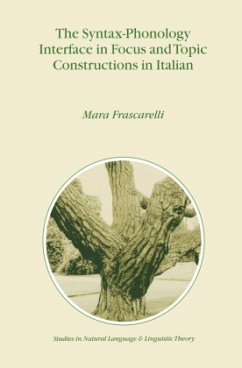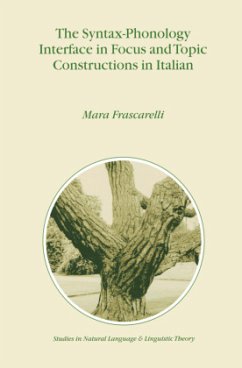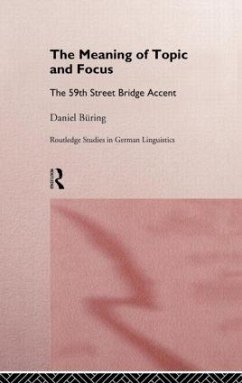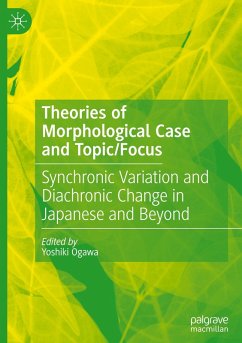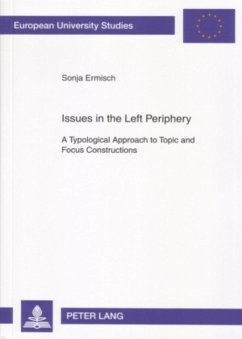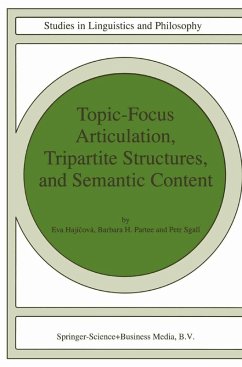
Topic Structure of the Chinese Language
Structural and Functional Analysis
Übersetzer: Jin, Dawei; Yan, Hanbo
Versandkostenfrei!
Versandfertig in 6-10 Tagen
91,99 €
inkl. MwSt.

PAYBACK Punkte
46 °P sammeln!
The current book is the first systematic exposition and analysis of the structure and meaning aspects of the Chinese topic-comment structure. While early analyses of the Chinese topic (and topicalization) phenomena abound, in terms of its theoretical depth and empirical breadth the current book is unparalleled.The phenomenon of topics is a core concept in modern linguistics, and its research significance extends beyond the scope of Chinese linguistics, being a topic of common concern in the international linguistic community. Based on the theoretical background of Universal Grammar and linguis...
The current book is the first systematic exposition and analysis of the structure and meaning aspects of the Chinese topic-comment structure. While early analyses of the Chinese topic (and topicalization) phenomena abound, in terms of its theoretical depth and empirical breadth the current book is unparalleled.
The phenomenon of topics is a core concept in modern linguistics, and its research significance extends beyond the scope of Chinese linguistics, being a topic of common concern in the international linguistic community. Based on the theoretical background of Universal Grammar and linguistic typology, the patterns of Chinese topics have strong consequences for the general linguistic theory, inform linguistic typology and lay the foundation for subsequent research. It is thus long overdue to translate the current book into English so that the insights, empirical generalizations and findings can reach a wider, global audience.
The original Chinese title, co-authored by two leading Chinese linguists, provides an empirically all-rounded and theoretically ground-breaking analysis of the topic in Chinese grammar. The entire book consists of seven chapters, introducing and comparing different approaches to the topic phenomenon from competing schools of thoughts within the field of theoretical syntax in China and abroad. It proposes a dedicated structural position of topics, distinguishes between subjects and topics, provides a taxonomy of topic, focus, as well as topic-focus, and explores the distribution and functions of topic markers (topic morphemes) across Sinitic languages. Aside from structural characterizations, the book also delves into the semantic relationships of topics. In particular, it examines the referential properties of topics, analyzes their discourse functions and licensing contexts, and summarizes the relationship between the topic structure and word order types. It ends with an analysis of the grammaticalization of Chinese topics and the resulting structures, as well as a proposal of the implications Chinese topics carry for the subject-topic typology, advocating for broader analyses along similar frameworks on other topic-prominent languages.
The phenomenon of topics is a core concept in modern linguistics, and its research significance extends beyond the scope of Chinese linguistics, being a topic of common concern in the international linguistic community. Based on the theoretical background of Universal Grammar and linguistic typology, the patterns of Chinese topics have strong consequences for the general linguistic theory, inform linguistic typology and lay the foundation for subsequent research. It is thus long overdue to translate the current book into English so that the insights, empirical generalizations and findings can reach a wider, global audience.
The original Chinese title, co-authored by two leading Chinese linguists, provides an empirically all-rounded and theoretically ground-breaking analysis of the topic in Chinese grammar. The entire book consists of seven chapters, introducing and comparing different approaches to the topic phenomenon from competing schools of thoughts within the field of theoretical syntax in China and abroad. It proposes a dedicated structural position of topics, distinguishes between subjects and topics, provides a taxonomy of topic, focus, as well as topic-focus, and explores the distribution and functions of topic markers (topic morphemes) across Sinitic languages. Aside from structural characterizations, the book also delves into the semantic relationships of topics. In particular, it examines the referential properties of topics, analyzes their discourse functions and licensing contexts, and summarizes the relationship between the topic structure and word order types. It ends with an analysis of the grammaticalization of Chinese topics and the resulting structures, as well as a proposal of the implications Chinese topics carry for the subject-topic typology, advocating for broader analyses along similar frameworks on other topic-prominent languages.



